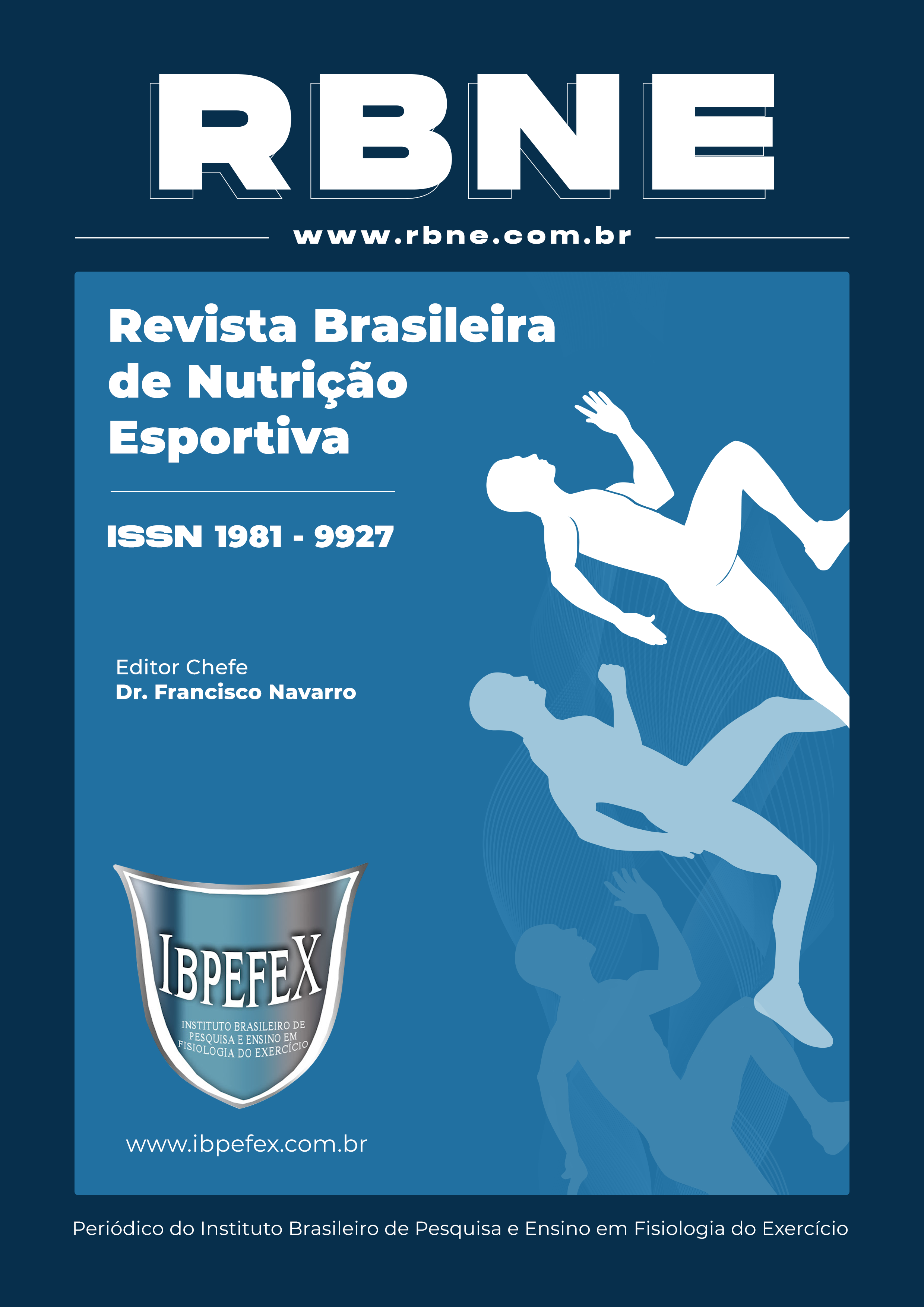Anthropometric and dietary intake assessment of brazil national cheerleading team
Abstract
Introduction and objective: Cheerleading is an emerging, dynamic and intense sport, with a strong aesthetic appeal. The aim of the study was to evaluate the anthropometric profile, body composition, food consumption and energy needs of athletes from the Brazilian cheerleading team. Materials and Methods: 53 athletes, men (n=18) and women (n=35), with an average age of 23.6 ±4.5 years answered a sociodemographic questionnaire and underwent an an anthropometric assessment (height, body mass, circumferences and skinfolds). Of these, 29 responded additionally to a 24 -hour food record. Results: The anthropometric values found for men (1.74 ±0.06 m; 79.3 ±12.2 kg; 11.5 ±5.4%) and women (1.60 ±0.06 m; 60, 0 ±12.5 kg; 22.5 ±7.2 %) are similar to those of athletes from other nationalities, with adequate BMI values and body fat percentage. The different positions held have significant differences, in which bases have higher values than flyers in all variables. Mean macronutrient intake (1.8 ±0.8 g/kg PTN, 3.4 ±1.1 g/kg CHO and 0.8 ±0.3 g/kg LIP) was in line with reference values and all have low energy availability (18.6 ±8.8 kcal/kg FFM). Correlations between variables were indirect between BF and EI (-0.44; moderately) and BF and PTN (-0.61; strong). Conclusion: This was the first study to evaluate Brazilian high-performance cheerleading athletes, then the results will support the work of professionals involved in the preparation of athletes and future research. Cheerleaders are athletes at risk for RED's, which reinforces the importance of proper nutritional support.
References
-Andreeva, A.; e colaboradores. Physiological profile of cheerleading adolescent girls in flying and basing postitions. Movement in Human Life and Health. Vol. 30. Num. 3. 2018.
-Astudillo, K.M.Y. Estado Nutricional, Balance Energético y Rendimiento Físico de adolescentes mujeres Cheerleaders Proyecto de investigación. Universidad San Francisco de Quito. 2019.
-Aviles, R.J. What Does it Take To Be a National Cheerleading Champion?Exercise Science Research Laboratory. 2013.
-Brito, H.B.B.L.; Santana, L.A. Análise da postura e da flexibilidade de atletas de cheerleading. Fisioterapia Brasil. Vol. 18. Num. 1. 2017. p. 12-18.
-Loucks, A.B.; Kiens, B.; Wright, H.H. Energy availability in athletes. Journal of sports Sciences. Vol. 29. 2011.
-Meng, K.; e colaboradores. The risk of low energy availability in Chinese elite and recreational female aesthetic sports athletes. Journal of the International Society of Sports Nutrition. Vol. 17. Num. 1. 2020. p. 1-7.
-Mountjoy, M.; e colaboradores. International Olympic Committee (IOC) Consensus statement on relative energy deficiency in sport (red-s): 2018 update. International Journal of Sport Nutrition and Exercise Metabolism. Vol. 28. Num. 4. 2018. p. 316-331.
-Potgieter, S. Sport nutrition: A review of the latest guidelines for exercise and sport nutrition from the American College of Sport Nutrition, the International Olympic Committee and the International Society for Sports Nutrition. South African Journal of Clinical Nutrition. Vol. 26. Num. 1. 2013. p. 6-16.
-Sánchez, P.U.; Elizondo, J.H. Energy expenditure and intensity of cheerleading training: A descriptive study. MHSalud. Vol. 18. Num. 2. 2021. p. 1-14.
-Santana, W.F. Cheerleading nos Jogos Olímpicos : novas perspectivas para o cenário esportivo brasileiro. Universidade de São Paulo. 2023.
-Smith, A.B.; e colaboradores. Examination of the Prevalence of Female Athlete Triad Components among Competitive Cheerleaders. International Journal of Environmental Research and Public Health. Vol. 19. Num. 3. 2022a. p. 1-18.
-Smith, A.B.; e colaboradores. Investigation of Eating Disorder Risk and Body Image Dissatisfaction among Female Competitive Cheerleaders. International Journal of Environmental Research and Public Health. Vol. 19. Num. 4. 2022b. p. 1-13.
-Sundgot-Borgen, J.; Garthe, I. Elite athletes in aesthetic and Olympic weight-class sports and the challenge of body weight and body composition. Journal of Sports Sciences. Vol. 29. Num. S1. 2011. p. 37-41.
-Thomas, D.T.; Erdman, K.A.; Burke, L.M. Nutrition and Athletic Performance. Medicine and Science in Sports and Exercise. Vol. 48. Num. 3. 2016. p. 543-568.
Copyright (c) 2024 Adrielle Caroline Ribeiro Lopes, Luiz Henrique Resende Maciel

This work is licensed under a Creative Commons Attribution-NonCommercial 4.0 International License.
Authors who publish in this journal agree to the following terms:
- Authors retain the copyright and grant the journal the right of first publication, with work simultaneously licensed under the Creative Commons Attribution License BY-NC which allows the sharing of the work with acknowledgment of the authorship of the work and initial publication in this journal.
- Authors are authorized to enter into additional contracts separately for non-exclusive distribution of the version of the work published in this journal (eg, publishing in institutional repository or book chapter), with acknowledgment of authorship and initial publication in this journal.
- Authors are allowed and encouraged to post and distribute their work online (eg, in institutional repositories or on their personal page) at any point before or during the editorial process, as this can bring about productive change as well as increase impact and impact. citation of published work (See The Effect of Free Access).






